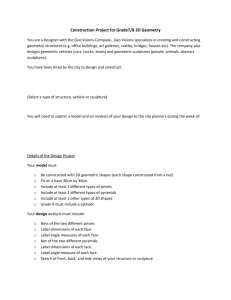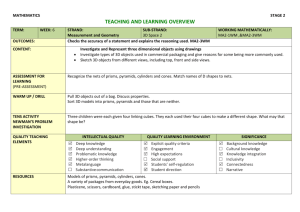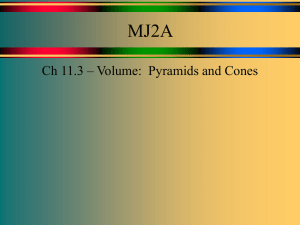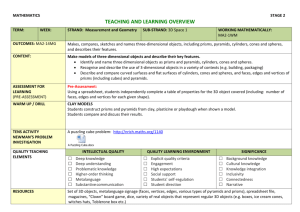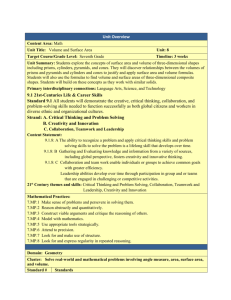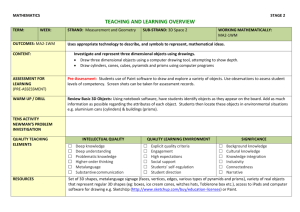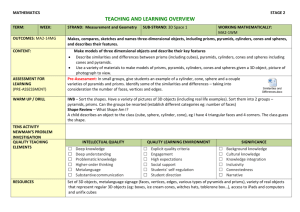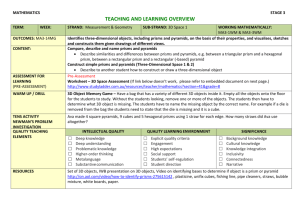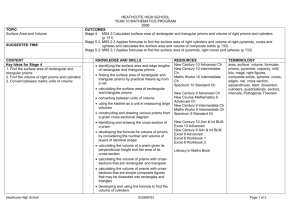learning activities (3d11)
advertisement
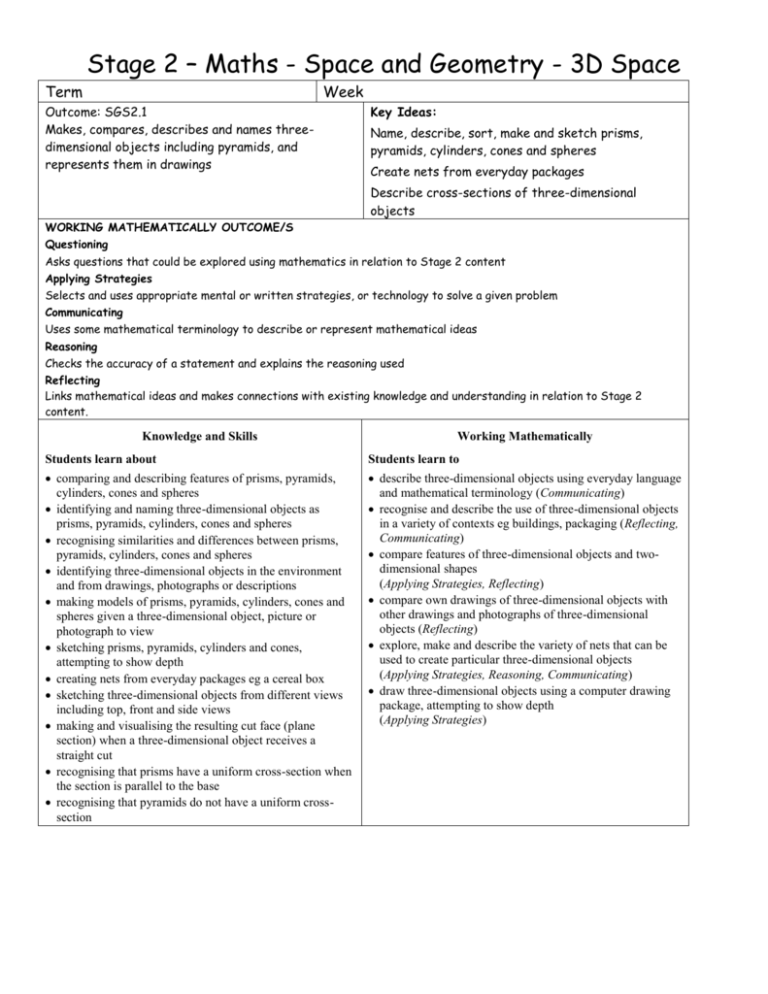
Stage 2 – Maths - Space and Geometry - 3D Space Term Week Outcome: SGS2.1 Makes, compares, describes and names threedimensional objects including pyramids, and represents them in drawings Key Ideas: Name, describe, sort, make and sketch prisms, pyramids, cylinders, cones and spheres Create nets from everyday packages Describe cross-sections of three-dimensional objects WORKING MATHEMATICALLY OUTCOME/S Questioning Asks questions that could be explored using mathematics in relation to Stage 2 content Applying Strategies Selects and uses appropriate mental or written strategies, or technology to solve a given problem Communicating Uses some mathematical terminology to describe or represent mathematical ideas Reasoning Checks the accuracy of a statement and explains the reasoning used Reflecting Links mathematical ideas and makes connections with existing knowledge and understanding in relation to Stage 2 content. Knowledge and Skills Working Mathematically Students learn about Students learn to comparing and describing features of prisms, pyramids, cylinders, cones and spheres identifying and naming three-dimensional objects as prisms, pyramids, cylinders, cones and spheres recognising similarities and differences between prisms, pyramids, cylinders, cones and spheres identifying three-dimensional objects in the environment and from drawings, photographs or descriptions making models of prisms, pyramids, cylinders, cones and spheres given a three-dimensional object, picture or photograph to view sketching prisms, pyramids, cylinders and cones, attempting to show depth creating nets from everyday packages eg a cereal box sketching three-dimensional objects from different views including top, front and side views making and visualising the resulting cut face (plane section) when a three-dimensional object receives a straight cut recognising that prisms have a uniform cross-section when the section is parallel to the base recognising that pyramids do not have a uniform crosssection describe three-dimensional objects using everyday language and mathematical terminology (Communicating) recognise and describe the use of three-dimensional objects in a variety of contexts eg buildings, packaging (Reflecting, Communicating) compare features of three-dimensional objects and twodimensional shapes (Applying Strategies, Reflecting) compare own drawings of three-dimensional objects with other drawings and photographs of three-dimensional objects (Reflecting) explore, make and describe the variety of nets that can be used to create particular three-dimensional objects (Applying Strategies, Reasoning, Communicating) draw three-dimensional objects using a computer drawing package, attempting to show depth (Applying Strategies) LEARNING ACTIVITIES (3D7) CONSTRUCTING PRISMS AND CYLINDERS Students build and stack attribute blocks, books or pattern blocks to develop the idea of a prism as an object having a constant crosssection. Students could build prisms using Base 10 naterial, Cuisenaire rods, Multilink, Centicubes, Lego bricks, Duplo bricks, pattern blocks or Unifix. BLINDFOLD Students handle and discuss geometric models or everyday examples of various prisms and cylinders whilst blindfolded. They count the faces, edges and corners and describe the shape of the faces. Then they take off the blindfold and repeat the activity, comparing results. Students could use a “feely bag” instead of being blindfolded. INVESTIGATING PRISMS AND CYLINDERS Students make prints of the faces and bases of prisms. A chart may be built up to illustrate the prints obtained from various prisms and cylinders. SORTING PRISMS Students sort collections of everyday objects into “objects which are prisms” and “objects which are not prisms”. Students could further sort their prisms into categories of their own choosing. PRISMS IN THE ENVIRONMENT Students go on a prism hunt, finding and drawing examples of prisms in their environment. Students could collect photographs of prisms from magazines and make a prisms book. LEARNING ACTIVITIES (3D8) PLAYING WITH PYRAMIDS Provide students with a variety of pyramids, eg having square, triangular, hexagonal or rectangular bases. Students discuss the faces, edges, corners and bases, noting the similarities and differences. Students stack sets of seriated shapes to form “pyramids”. Although such stacks are not strictly pyramids, they allow students to explore the idea that the cross-sections parallel to the base become progressively smaller the further away from the base they are taken. Ask students to sort the collection of pyramids according to some attribute related to size, eg height. PRINTING WITH PYRAMIDS Students make prints using the faces and bases of a variety of pyramids and construct a chart of results. BLINDFOLD Students handle models of different pyramids with their eyes closed, describing and counting the faces, edges and corners. The activity may then be repeated with the students having their eyes open and noting any differences in their descriptions. Similar activities could be arranged with pyramids being included with other objects in a “feely bag”. PYRAMID PAINT Students choose a model of a pyramid and paint each of its faces a different colour. Students investigate how many faces they can touch at once, how many faces meet at any one corner, etc. Students could list the colours that meet at each corner and comment on the possible combinations. PRYAMID HUNT Students find examples of pyramids in the real world and make collections of objects and photographs, eg the Egyptian Pyramids, glasshouses, drink cartons. CLASSIFICATION Students sort models into prisms, pyramids and those that are neither. LEARNING ACTIVITIES (3D9) LEARNING ACTIVITIES (3D10) NETS CONSTRUCTING PYRAMIDS Students collect boxes, then cut and fold them to form nets. The nets of various prisms may be compared and discussed. The nets can be refolded and the shape made inside out. Students could consider whether the same figure can have more than one net, eg consider which hexominoes can be folded to form a cube. Students could be given cut-out nets and asked to fold and glue to form the three dimensional shape. Alternatively, drawings of nets could be given to students, who then copy the nets using interlocking plastic squares, triangles and pentagons (Polydrons). The copied net can then be folded and clipped together to form the 3D shape. Cardboard shapes are available which can be joined by elastic bands to form 3D shapes. Students could investigate these shapes. • Students construct pyramid models using clay, plasticine or playdough. Using wire or a knife, students can slice models parallel to the base and investigate the cross-sections. The truncated solids could then be investigated. Students could predict the results obtained from taking slices at an oblique angle to the base and check their predictions • The teacher provides nets of pyramids which students fold and stick together. The various forms of the net which fold to give the same 3D solid could be investigated. • Students build pyramids using interlocking plastic shapes such as Polydrons. With different coloured squares, the task of counting the faces, edges and corners is simplified. • Students use cardboard shapes and elastic bands to build pyramids. Students construct prisms from clay, plasticine or playdough. RESEARCH CLAY MODELS SKELETONS Students make skeletal models of pyramids using toothpicks, pipe cleaners or straws. Students compare and discuss their results. CONSTRUCTING NETS BY TRACING Students may trace templates of regular polygons onto cardboard or paper to form given nets. These may then be folded into their 3D forms, painted and labelled. MAKING SKELETAL MODELS Skeletons may be made using such materials as toothpicks, straws and pipe cleaners. Students could study the rigidity of the various models. INVESTIGATING CROSS-SECTIONS Students make prisms from clay, plasticine or playdough. By carefully cutting the models with a piece of wire or a knife, the cross-sections may be studied. Students make various sections at right angles to the axis and note the results. They then predict the shapes resulting from cutting at an oblique angle or cutting with a curved blade and perform the section to check their predictions. • Students research the building of the Egyptian Pyramids. A wall chart could be produced, showing the number of workers involved, construction techniques, dimensions, time taken, etc. • Students find other examples of pyramidal structures, such as the glasshouse in the Royal Botanic Gardens, Sydney. Research the reasons for a pyramidal shape being chosen, its advantages and disadvantages, construction difficulties, etc. Drawings and photographs could illustrate the research in a wall chart. UNIQUENESS OF BASE Students handle a variety of models of pyramids and decide whether the base is unique or whether any face could be the base. Models of tetrahedrons should be included. LEARNING ACTIVITIES (3D11) BUILDING MODELS • Students collect photographs or pictures of everyday objects from magazines. Students find objects in the photographs which are based on prisms and model them. Material used may be papier-mache, blocks, Lego bricks, etc. • Students build Lego and other models according to instructions and plans. SPATIAL VISUALISATION • Students draw classroom objects from different viewpoints, eg side, top, front. Grid paper may be used. Repeat for everyday objects chosen by the students. • Students are given photographs or various objects and are asked to draw one of the objects from a different view. FIND IT Students are given cards prepared by the teacher showing various everyday objects as seen from different viewpoints. Students have to name the object using as few of the teacher’s cards as they can. SOLIDS Students study drawings of solids from various viewpoints, eg top, sides, and identify the solid by choosing from a range of models. DRAW IT • The teacher shows the students a box or packet and asks them to draw what they think it looks like from some particular viewpoint. • The students draw their prediction for the net of the box or packet. The teacher then cuts and unfolds the box or packet to form the net and this is compared with the students’ drawings. SHAPE IN THE ENVIRONMENT Ask students to draw pictures of everyday objects as they imagine they would look from various viewpoints, eg a car from directly above. UNSEEN FACES The teacher gives students drawings of various rectangular prisms made from interlocking cubes. The students have to say how many of the cubes would have three faces, two faces, one face and no faces visible in the actual model. Have students check by building the model. 3 faces - 8 cubes 2 faces - 16 cubes 1 face - 6 cubes Links Resources Blocks, cups, glasses, geometric models, Lego bricks, models, construction kits, dolls’ house furniture, grip paper, photographs. Technology Relevant positional language is used to describe and label plan views and drawings (Position) Links to other key learning areas Visual Arts – Selects and explores different aspects of subject matter in particular ways in their making of artworks eg construction techniques in sculpture and ceramics Language prism, pyramid, cylinder, cone, sphere, cube, cross-section, solid, hollow, inside out, skeleton, angle, face, surface, edge, base, corner, complete, completion, description, direction, represent, representation, view, viewpoint Assessment Ask students to • look at a drawing or photograph and make a reasonable model of the object using various materials • draw different views of a given object • identify an object, given drawings taken from various viewpoints • match drawings with objects. Evaluation • Did I give students time to discuss their findings amongst themselves? • Were classroom activities adequate in addressing the unit objectives?
